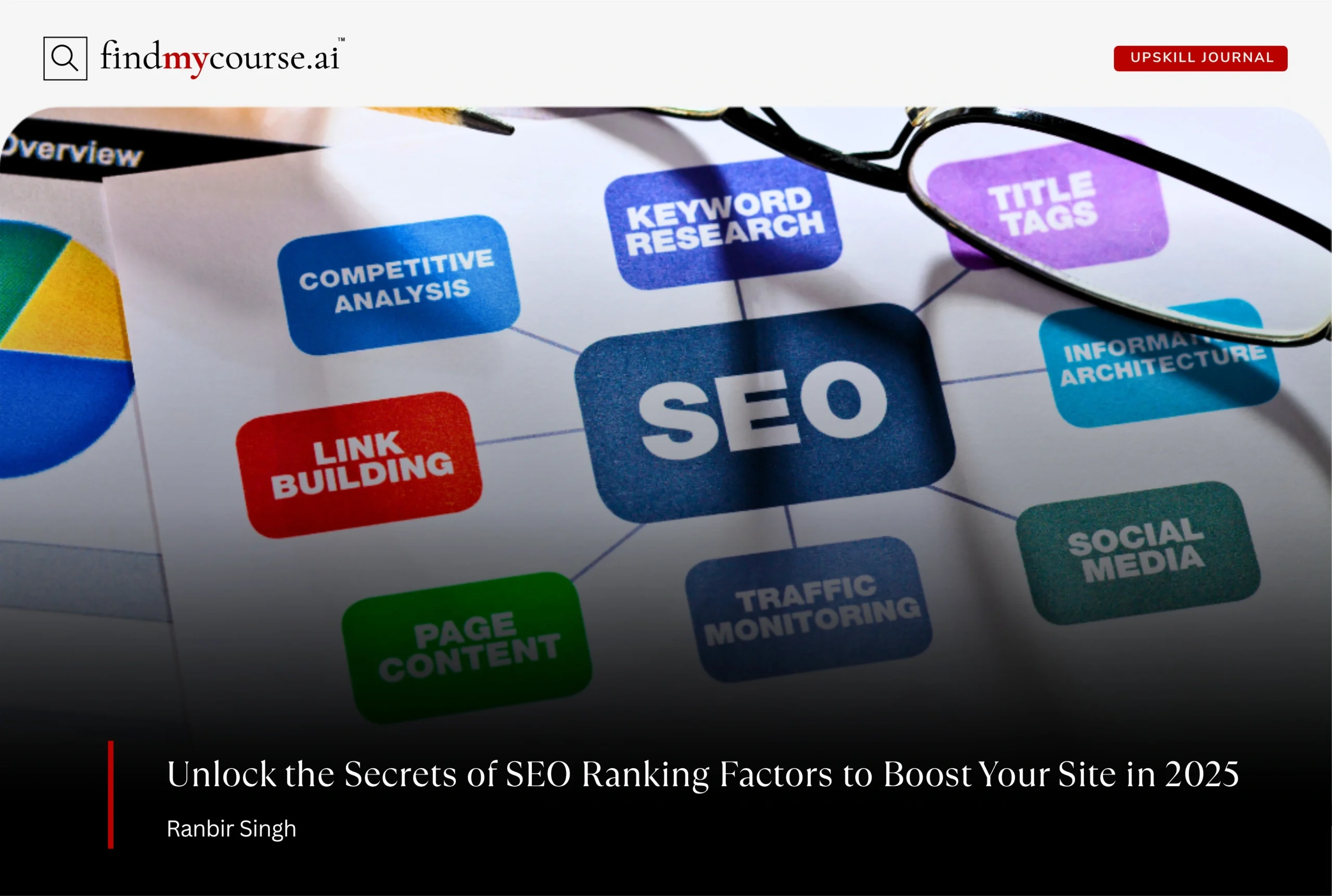In the fast-paced digital world, staying visible online is no longer optional—it’s essential. Search engines have grown smarter, and user expectations have never been higher, making SEO a cornerstone of any successful online strategy. To achieve top visibility, it’s crucial to understand the factors that determine how websites are ranked in search results. Understanding these key SEO ranking factors is now more critical than ever for marketers, content creators, and professionals eager to upskill and stay ahead of the competition. This guide will walk you through the top 10 SEO ranking factors for 2025, providing actionable insights to boost your website’s visibility, authority, and performance in search results.
What Are SEO Ranking Factors?
SEO ranking factors are the criteria that search engines use to determine how websites appear in search results. Simply put, they are the signals that tell Google, Bing, or other search engines which pages are most relevant, trustworthy, and valuable to users. These factors range from the quality of your content to technical aspects of your website, as well as user engagement and external signals like backlinks.
Understanding SEO ranking factors is essential because it allows you to optimize your website strategically rather than relying on guesswork. So, by aligning your site with these factors, you can improve visibility, attract more organic traffic, and provide a better experience for your audience. In 2025, the landscape has evolved to include AI-driven search, mobile-first design, and deeper measures of trust and authority, making it more important than ever to stay informed.
Top 10 SEO Ranking Factors for 2025
To achieve higher visibility and outperform competitors in search results, it’s essential to understand the factors that influence how search engines rank your website. Moreover, these SEO ranking factors combine content quality, technical optimization, user experience, and emerging trends like AI-driven search, forming the foundation of a strong digital strategy.
Here are the top 10 SEO ranking factors you should prioritize in 2025:
1. High-Quality, Helpful Content & Search Intent
High-quality content that satisfies user intent is the cornerstone of SEO in 2025. Search engines now prioritize content that is not only accurate but genuinely helpful and actionable. This means answering questions thoroughly, covering related subtopics, and providing insights users can trust. Tools like Ahrefs or SEMrush can help identify what your audience is searching for and the intent behind their queries. Conduct keyword research with these tools and create content that directly addresses the questions and needs your audience has. Use headings, bullet points, and examples to make your content easy to read and engaging. Thus, by aligning content with what users truly want, your pages are more likely to rank higher and attract sustained traffic.
2. Experience, Expertise, Authoritativeness, and Trustworthiness (E-E-A-T)
Google’s E-E-A-T framework has become a cornerstone of ranking in 2025, emphasizing the importance of real-world experience, subject-matter expertise, and authoritative content. Demonstrating these qualities helps search engines trust your website, especially for YMYL (Your Money or Your Life) topics where credibility directly affects rankings. Showcasing credentials, citing reputable sources, and building a strong online reputation are essential steps to strengthen E-E-A-T and improve your site’s visibility.
| Component | What It Means | How to Apply |
| Experience | Real-world involvement or practical knowledge in your niche | Include case studies, personal insights, or project examples |
| Expertise | Demonstrated knowledge and skills in a subject | Highlight author credentials, certifications, or expert contributors |
| Authoritativeness | Recognized as a trusted source in your industry | Earn backlinks from reputable sites, contribute to industry publications |
| Trustworthiness | Reliability and integrity of your content | Cite authoritative sources, maintain transparent contact info, secure your site (HTTPS) |
3. Quality and Relevant Backlinks
Backlinks continue to be a critical SEO ranking factor, but in 2025, quality outweighs quantity. Search engines value links from authoritative, relevant websites more than a high number of low-quality links. Context and placement also matter—links naturally embedded in relevant content signal trustworthiness and improve your ranking potential.
Key takeaways:
- Focus on backlinks from reputable, industry-specific sites.
- Ensure links appear naturally within relevant content.
- Avoid spammy or low-quality link-building tactics.
- Use tools like Moz to monitor backlink quality.
4. Page Experience & Core Web Vitals (CWV)
User experience is a major SEO ranking factor in 2025, with Core Web Vitals—loading speed, interactivity, and visual stability—directly influencing rankings. Websites that load quickly, navigate smoothly, and avoid disruptive layout shifts keep visitors engaged, reduce bounce rates, and improve overall performance. Optimizing page speed using tools like Google PageSpeed Insights, ensuring mobile-friendly layouts, and minimizing unexpected content shifts are essential steps to enhance page experience and satisfy both users and search engines.
5. Mobile-First Optimization
With mobile traffic dominating, Google now evaluates websites primarily on their mobile versions. Ensuring responsive design, fast-loading pages, and touch-friendly navigation is crucial for both rankings and user experience. Mobile optimization also improves accessibility and supports proper indexing by search engines.
Key tips:
- Use responsive design to adapt to all screen sizes.
- Optimize images and scripts for faster mobile loading.
- Ensure navigation is easy and touch-friendly.
- Test mobile performance using Mobile-Friendly Tests.
6. Topical Authority & Content Clusters
Establishing topical authority is essential in 2025, as search engines favor websites that demonstrate expertise on a subject. Creating content clusters—interlinked articles around a central topic—signals depth and authority while improving internal linking, making it easier for both users and crawlers to navigate your site. Websites that provide comprehensive coverage on a topic are more likely to rank higher and attract sustained organic traffic, reinforcing credibility and relevance in their niche.
7. User Engagement Signals
Search engines use user engagement metrics to evaluate the value of your content. Positive engagement indicates that users find your content helpful, which can boost rankings.
| Engagement Metric | What It Measures | Why It Matters |
| Click-Through Rate (CTR) | Percentage of users clicking your link in search results | Higher CTR signals relevant and appealing content |
| Time on Page | How long visitors stay on a page | Longer time suggests valuable and engaging content |
| Bounce Rate | Percentage of users leaving quickly | Lower bounce rates indicate content meets user needs |
8. Optimized for AI Overviews / Generative Search
The rise of AI-powered search features means your content can now appear in generative search overviews and AI summaries. Optimizing for this trend involves providing clear, structured answers, using headings and bullet points, and aligning content with conversational queries. In addition, creating content that AI models can easily parse can improve visibility in emerging AI-driven search results.
9. Technical SEO (Crawlability & Indexability)
Technical SEO forms the foundation for all other ranking factors. Ensuring your website is crawlable and indexable allows search engines to access and understand your content efficiently. Key elements include clean URL structures, properly configured XML sitemaps, canonical tags, and robots.txt files. Strong technical SEO not only improves indexing but also supports better rankings, smoother user experiences, and easier navigation for both visitors and search engine crawlers.
10. On-Page Optimization (Headers, Meta Data, Image Alt Text)
On-page SEO is a practical and essential way to boost rankings. Optimizing headers, meta titles, descriptions, and image alt text helps search engines understand the context and relevance of your content. It also improves user experience by making pages more scannable, accessible, and easier to navigate.
| Element | Purpose |
| Headers (H1–H3) | Structure content for readability and help search engines understand hierarchy |
| Meta Titles & Descriptions | Summarize page content and improve click-through rates from search results |
| Image Alt Text | Describe images for accessibility and help search engines index visual content |
| Internal Linking | Guides users and crawlers to related content, enhancing engagement and SEO |
How to Implement SEO Ranking Factors Effectively
Understanding the top SEO ranking factors is just the first step—success comes from putting them into practice. Here’s how you can implement them strategically:
- Audit Your Existing Content: Identify pages that need improvement in terms of quality, relevance, or technical SEO.
- Prioritize High-Impact Areas: Focus on factors that give the biggest ROI, like content quality, backlinks, and mobile optimization.
- Create a Content Strategy: Develop clusters of interlinked content to establish topical authority and satisfy user intent.
- Optimize for AI and Voice Search: Structure your content with clear headings, bullet points, and conversational answers to capture emerging AI-driven search opportunities.
- Track and Measure Performance: Use analytics tools to monitor traffic, engagement, and ranking improvements, adjusting strategies based on real data.
Conclusion
SEO in 2025 is more sophisticated and user-focused than ever. Understanding ranking factors is important, but action is key. By auditing content, prioritizing high-impact areas, building content clusters, optimizing for AI and voice search, and tracking performance, you can achieve measurable results. SEO is an ongoing process—websites that align with ranking factors, deliver great user experiences, and adapt to emerging trends will enjoy lasting visibility, authority, and a competitive edge. And if you ever feel stuck or need guidance, just ask our AI assistant for help to stay on track.


